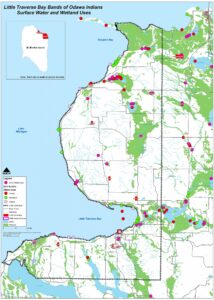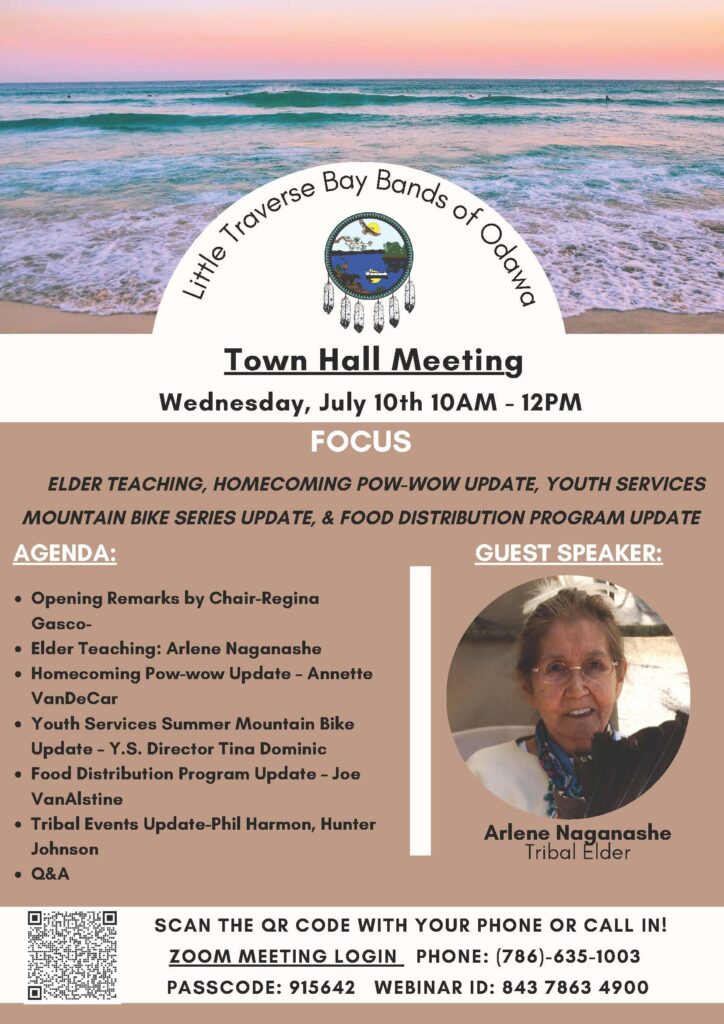General Election: June 28, 2021 Candidates for Tribal Council
RICKY COMPO
TAMARA KIOGIMA
LEROY SHOMIN
DOUG EMERY
WILLIAM ORTIZ
MARCI REYES
KENNETH DEWEY
AARON OTTO
SHARON SIERZPUTOWSKI
SIERRA BODA (WITHDREW 5-14-21)
We are a tribe rich with water resources. Our reservation contains 232 lakes, reservoirs, and ponds, 394 miles of rivers and streams, and 35,647 acres of wetlands. Our water resources touch two Great Lakes. The 1,664 square mile Boardman-Charlevoix watershed drains west into Lake Michigan. The 1,406 square mile Cheboygan watershed drains east towards Lake Huron.
The LTBB are people of the water. The Odawa people originated from the water and will return to the water. The plants, wildlife, and aquatic life that are dependent on clean water are used for cultural, ceremonial, medicinal uses, and for food.
LTBB were able to stay in their homeland and migrate due to their capability to navigate on the Great Lakes and through the inland waterways. The Odawa people have historically known how to utilize wetlands, inland lakes and creeks, rivers, and streams. These skills to utilize these resources did not go unnoticed. The French became an alliance with LTBB and sought out knowledge from LTBB on their abilities use these land and water resources. LTBB people still depend on water resources for hunting, fishing, gathering, water filtration, groundwater recharge, and medicinal purposes. LTBB understands the responsibility to protect, prevent, and sustain water resources for the next seven generations.

Of all our tribal waters, our citizens state that they use Lake Michigan and Little Traverse Bay the most, followed by Burt Lake, Spirit Lake, Bear River, Crooked Lake, Sturgeon Bay, and Lake Charlevoix. We use our waters for hunting, fishing, gathering, ceremonial, cultural, and recreational purposes. Swimming, fishing, and boating/kayaking are among the most popular recreational uses of our water resources.
The map legend divides uses into the following categories: Wetlands, Cultural, Fishing and Recreational. The marked wetlands area general category that can include hunting, gathering, and ceremonial activities. Cultural uses include wild rice areas, traditional, and ceremonial uses. Fishing uses include coldwater, warmwater, warmwater with principal migratory routes for anadromous salmonids (waters that salmonid species migrate into to spawn), subsistence fishing (provide food for families or community) and coolwater. Recreational uses include primary contact (immersion of the whole body) and secondary contact,(body in the water but not immersion of the head). LTBB waters are also used for a public water supply (treating water to supply citizens with drinking water), indigenous aquatic life and wildlife, navigation, commercial, industrial, aquaculture, and agricultural uses.
Click on the map to download and zoom in.
Groundwater is also vital to the health of our water resources because it recharges our surface waters. It also provides LTBB citizens with water for drinking and household needs because many of our citizens have wells or are on a community well system. When a citizen has a well, the water that is pumped comes from a groundwater aquifer.
Healthy lakes and streams are vital to Odawa culture and way of life. LTBB Environmental Staff conduct the tribes Surface Water Quality Protection Program (SWQPP) to monitor the health of LTBB’s water resources.
LTBB’s water quality data, collected since 2000, tell a story as to how healthy our waters are and help us prioritize our actions to better protect them.
Overall, most of LTBB’s waters are in very good or good health when looking at chemical and biological indicators measured through the SWQPP. It is critical to keep this healthy trend going in the years to come. Where LTBB’s waters are fair (yellow) or poor (red), it is essential to understand what activities are affecting these waters and determine the steps necessary to improve their condition.
A variety of activities affect the quality of LTBB’s surface and groundwater resources. Changes to the natural stream channels and adjacent riparian areas, referred to as hydromodification and habitat alteration, from culverts, bridges, and dredging, cause erosion, increase phosphorus and nitrogen levels, and increase temperatures, as well as obstruct fish passages. These changes affect river and stream fisheries because fish can’t find spawning areas or hiding places in streams with thick deposits of sediment, and high temperatures affect their ability to reproduce and survive. Polluted storm water runoff, referred to as nonpoint source pollution, from roadways, developed areas, and poorly managed agricultural practices can also decrease water quality. Pollutants released into the atmosphere can travel yards or miles before depositing on LTBB’s land and water resources. This type of pollution, referred to atmospheric deposition, is one way chemicals like mercury and PCBs can enter LTBB’s water resources and fisheries.
Where water resources aren’t meeting water quality standards, those waters are considered impaired. Although LTBB’s waters are relatively healthy, some impairments do exist. Alterations of channels and riparian areas cause about half of the impairments on the LTBB reservation. Stormwater runoff from urban areas is the second leading cause of impairment, followed by transportation infrastructure (including road maintenance), atmospheric deposition, agriculture/aquaculture, and marinas/boating. The Crooked River watershed, which flows toward Lake Huron, has the most impairments, with 33 impaired reaches.
Water quality standards are the regulatory foundation for protecting our water resources. Water quality standards define the goals for a waterbody by designating its uses, setting criteria to protect those uses, and establishing provisions to protect water quality from pollutants. If a waterbody exceeds its water quality standards, it is an indication that actions are needed to reduce pollutants and restore water quality health to support the waterbody’s designated uses, like drinking water supply or swimming.
At this point in time, LTBB doesn’t have tribal water quality standards in place. But that doesn’t mean LTBB’s waters aren’t protected. When LTBB Environmental Staff assess tribal waters, they use an assortment of water quality standards from various sources adopted by the Michigan Department of Environmental Quality (DEQ), the federal Environmental Protection Agency (EPA), Wisconsin Department of Natural Resources, and academia as the yardstick for measuring water quality health.
Groundwater is protected differently than surface waters. There is a Federal Safe Drinking Water Act (SWDA) that does provide legal limits on the levels of certain contaminants in drinking water. Community wells are protected under the Safe Drinking Water Act as well a host of other types of systems. To learn more about what types of wells are protected and the SDWA please click on this link: http://www.epa.gov/safewater/sdwa/pdfs/fs_30ann_sdwa_web.pdf.
Private wells are not protected by law. It is up to the private well owner to make sure the drinking water is safe. The Center for Disease Control and Prevention (CDC) recommends that private well owners test drinking water for certain contaminants once a year. For more information on private well testing, visit CDC Drinking Water page.
Although Michigan EGLE water quality uses and associated standards provide a basis for summarizing LTBB’s water quality conditions, Michigan’s uses do not address all of LTBB’s tribal waterbody uses, such as cultural uses, ceremonial uses, and subsistence fishing.
According to the 2014 LTBB citizen survey, water quality, rivers, and lakes was one of the top five issues that tribal citizens said need laws and regulations developed by the Tribe. LTBB water quality standards would protect LTBB waters from pollution while addressing our specific tribal water resource uses. Our own tribal water quality standards and uses will help to ensure LTBB’s waters remain in very good condition to support our cultural and recreational uses for the next seven generations.
Tribal legislation will include an overarching statute that will define what waters are to be protected. Uses and standards would protect a several types of surface waters, including springs, wetlands, and lakes, streams, creeks, rivers, and Lake Michigan. LTBB also intends to protect groundwater.
LTBB Environmental Staff have formed a Water Quality Protection Workgroup. The Workgroup consists of Executive and Legislative Branch members. The goal of the Workgroup is to develop tribal water quality standards and uses that will maintain the high quality of LTBB waters to support our many tribal water uses.
One of the first steps that the Workgroup will undertake in developing tribal water quality standards and uses is to survey all LTBB citizens to find out which water uses and on what water bodies are the highest priority. This will help the Workgroup craft the most protective water quality standards for LTBB’s waters.
A survey conducted in 2016 helped to guide the water quality standards and uses development process, increase community awareness on water quality and environmental protections, and show what types of water resources and uses are important to our citizens.
For more information on the Workgroup’s efforts to develop tribal water quality standards for LTBB water resources, contact LTBB Environmental Services at (231) 242-1574 or email Lauren Dey at ldey@ltbbodawa-nsn.gov.
RICKY COMPO
TAMARA KIOGIMA
LEROY SHOMIN
DOUG EMERY
WILLIAM ORTIZ
MARCI REYES
KENNETH DEWEY
AARON OTTO
SHARON SIERZPUTOWSKI
SIERRA BODA (WITHDREW 5-14-21)
BERNADECE (BERNIE) BODA & LINDA GOKEE
REGINA GASCO-BENTLEY & STELLA KAY
(Click Team To Read Their Statements)
BERNADECE (BERNIE) BODA & LINDA GOKEE
REGINA GASCO-BENTLEY & STELLA KAY
(Click Candidate Name To View Their Statement)
Search Code Index
function search(string){ window.find(string); }
LTBB Events
Sun Mon Tue Wed Thu Fri Sat 

Contact SPRING
[ninja_form id=12]
https://app.hellosign.com/s/LJki90VA